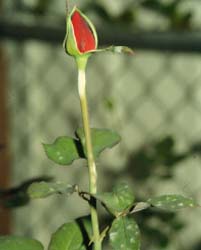
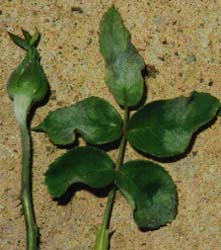
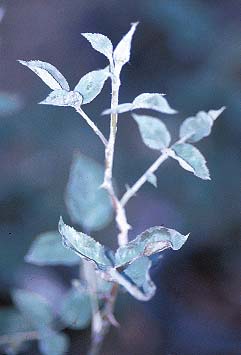
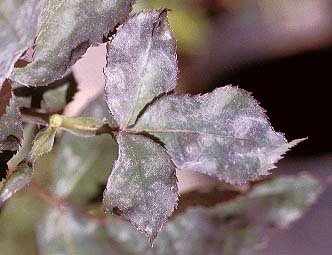
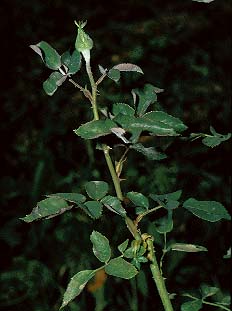
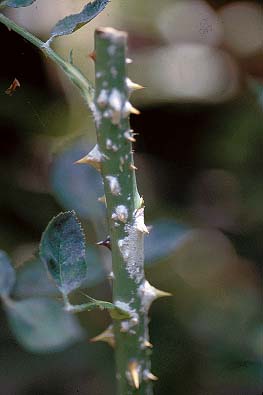
CAUSAL ORGANISM: Sphaerotheca pannosa (Wallroth ex Fr.) LÚv. var. rosae Woronichine
Powdery mildew is one of the most prevalent and serious diseases of roses. It is usually serious in dry climates like California but can occur as well in more humid regions over a wide range of moderate temperature conditions. While no complete resistance is observed, some roses would seem to be more susceptible than others.






SYMPTOMS: The first symptoms appear as slightly raised blister like areas on the upper leaf surfaces. Later, the young expanding leaves become twisted, distorted and covered with a white powdery mass of mycelium and spores. Young peduncles, sepals, petals and stems may also show distortion while growing tips and buds may be killed. Infected older leaves and stems may remain symptomless.
DISEASE CYCLE: The fungus can over winter as dormant mycelium or resting spores (cleistothecia) on infected stems or leaves. As conditions warm in spring, dormant mycelia becomes active producing asexual spores (conidia) while the cleistothecia germinate forming ascospores. Conidia and ascospores are then carried by the wind to susceptible young plant parts.
Optimum conditions for spore germination is 71░ F and 98 percent relative humidity. Temperatures above 90░ F and the presence of free moisture will inhibit spore germination. After spores germinate they form a short mycelium and directly penetrate the epidermis forming a haustoria inside the plant cell. The haustoria is a fungus structure that takes the nutrients from the plant. Successful infection will result in further development of mycelium, colonization of more plant tissue and production of secondary spores (conidia).
Air movement is important in dispersal of primary and secondary spores. Closely planted gardens with some air movement are ideal conditions for spread of this disease. Spore maturation and release usually occurs during the day when relative humidity is low, at night an increase in relative humidity favors spore germination and penetration of the fungus. Cool damp nights and warm sunny days favor the development of Powdery Mildew.
CONTROL: Dormant pruning and cleaning up old leaves can remove substantial amounts of primary inoculum. Sanitation should always be the initial means of control. When roses are pushing new spring growth the conditions for disease development are also favorable. At this time, protection can be gained from the use of fungicidal sprays applied at 7 to 10 day intervals. Fungicides in a wettable powder formulation may provide better coverage if used with a spreader sticker, most flowable formulations already have this property. While the old stand by (lime sulfur) is a good protectant fungicide, it may burn foliage under warm conditions. Several new fungicide products now claim to have some systemic and eradicative properties but don't expect to cure a severe disease situation. Fungicides will work best in the initial stages of disease development, not after massive infection has already taken place. Remember, fungicides are chemicals that have a degree of toxicity and should only be used when needed and strictly according to the label.
Horst, R. K. 1983. Compendium of Rose Diseases. The American Phytopathological Society, St. Paul, Minnesota. Pp. 5-7 and Color Plates 1-7.
![]()
If you have any questions or constructive comments, I would love to hear from you, please send e-mail to Baldo Villegas
[ Home ]
[ Rose Pests Master List]
[ Rose Diseases ]
[ Insect, Mites, and other Animal Pests ]
[ Abiotic Rose Problems ]
[ Weed Pests ]
[ Hawaii Pests ]
[ The Good Guys ]
[ Help! Rose IPM ]
[ Horticulure Links ]
Copyright© 1995-2002 by Baldo Villegas
Last updated: January 21, 2002